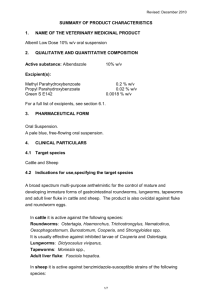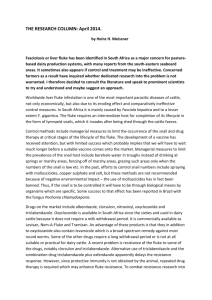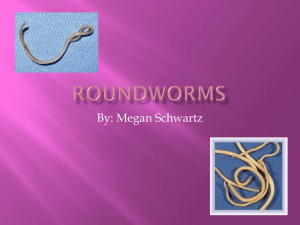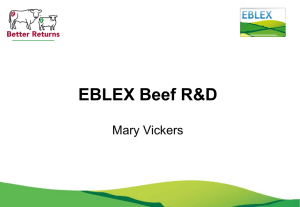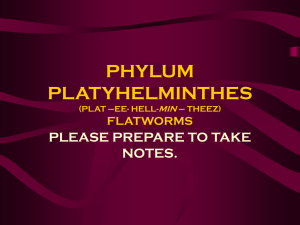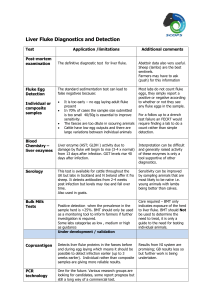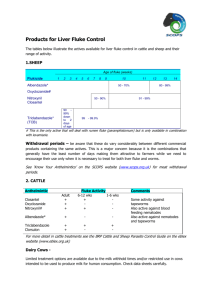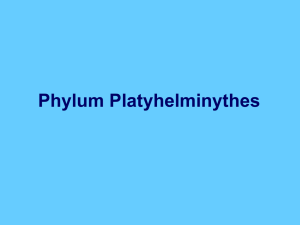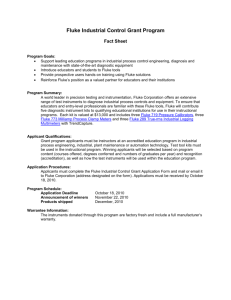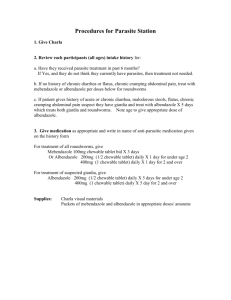Vm - Veterinary Medicines Directorate
advertisement
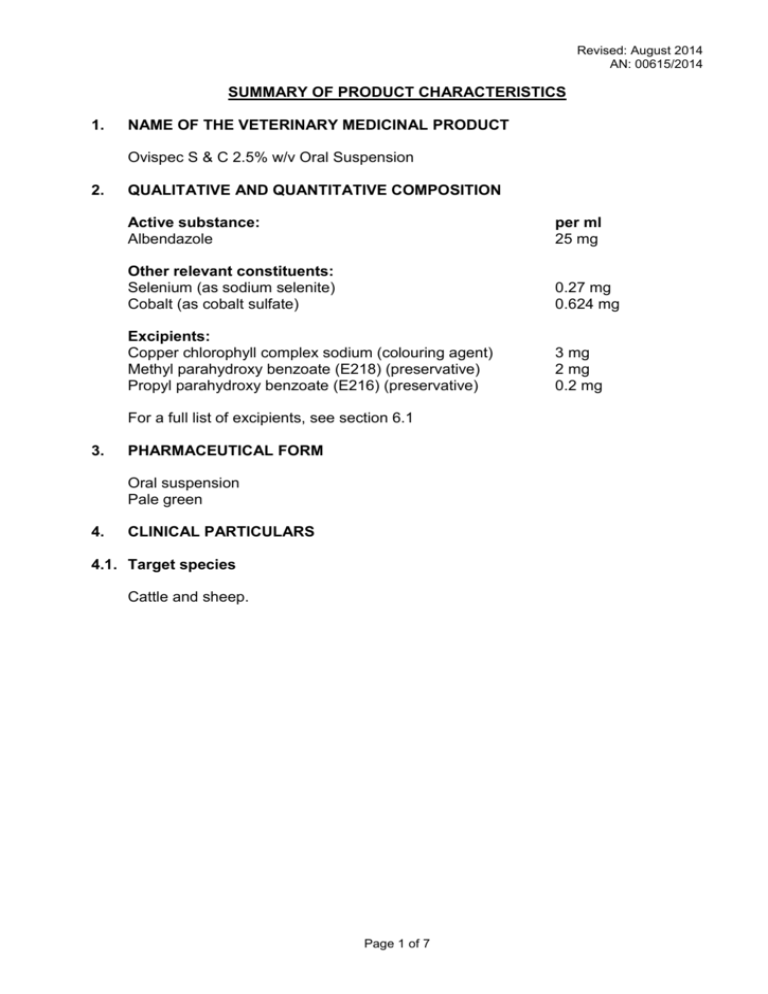
Revised: August 2014 AN: 00615/2014 SUMMARY OF PRODUCT CHARACTERISTICS 1. NAME OF THE VETERINARY MEDICINAL PRODUCT Ovispec S & C 2.5% w/v Oral Suspension 2. QUALITATIVE AND QUANTITATIVE COMPOSITION Active substance: Albendazole per ml 25 mg Other relevant constituents: Selenium (as sodium selenite) Cobalt (as cobalt sulfate) 0.27 mg 0.624 mg Excipients: Copper chlorophyll complex sodium (colouring agent) Methyl parahydroxy benzoate (E218) (preservative) Propyl parahydroxy benzoate (E216) (preservative) 3 mg 2 mg 0.2 mg For a full list of excipients, see section 6.1 3. PHARMACEUTICAL FORM Oral suspension Pale green 4. CLINICAL PARTICULARS 4.1. Target species Cattle and sheep. Page 1 of 7 Revised: August 2014 AN: 00615/2014 4.2. Indications for use, specifying the target species A broad spectrum multi-purpose anthelmintic for the control of mature and developing, immature forms of gastrointestinal roundworms, lungworms, tapeworms and adult liver fluke in cattle and sheep. The product is also ovicidal against fluke and roundworm eggs. In Cattle It is active against the following species: Roundworms: Teladorsagia, Haemonchus, Trichostrongylus, Nematodirus, Oesophagostomum, Bunostomum, Cooperia and Strongyloides spp. It is usually effective against inhibited larvae of Cooperia and Teladorsagia. Lungworms: Dictyocaulus viviparus. Tapeworms: Moniezia spp. Adult liver fluke: Fasciola hepatica. The product is ovicidal and will kill fluke and roundworm eggs, thus reducing pasture contamination. In Sheep It is active against benzimidazole-susceptible strains of the following species: Roundworms: Teladorsagia, Haemonchus, Trichostrongylus, Nematodirus (including N. battus), Chabertia and Oesophagostomum. It is usually effective against inhibited larvae of Teladorsagia. Lungworms: Dictyocaulus filaria. Tapeworms: Moniezia spp. Adult liver fluke: Fasciola hepatica. The product is ovicidal and will kill fluke and roundworm eggs, thus reducing pasture contamination. 4.3. Contraindications Do not use in animals with known hypersensitivity to the active ingredient. Page 2 of 7 Revised: August 2014 AN: 00615/2014 4.4. Special warnings for each target species Cattle suffering from severe lung damage due to heavy lungworm infestation may continue to cough for some weeks after dosing. Care should be taken to avoid the following practices because they increase the risk of development of resistance and could ultimately result in ineffective therapy: Too frequent and repeated use of anthelmintics from the same class, over an extended period of time. Underdosing, which may be due to underestimation of body weight, misadministration of the product, or lack of calibration of the dosing device (if any). Suspected clinical cases of resistance to anthelmintics should be further investigated using appropriate tests (e.g. Faecal Egg Count Reduction Test). Where the results of the test(s) strongly suggest resistance to a particular anthelmintic, an anthelmintic belonging to another pharmacological class and having a different mode of action should be used. Resistance to benzimidazoles has been reported in Teladorsagia, Haemonchus, Cooperia and Trichostrongylus species in small ruminants. Resistance to albendazole has been reported in Cooperia and Teladorsagia species in cattle in New Zealand. Therefore the use of this product should be based on local (regional, farm) epidemiological information about susceptibility of nematodes and recommendations on how to limit further selection for resistance to anthelmintics. To reduce this risk, dosing programmes should be discussed with a veterinary surgeon. 4.5. Special precautions for use Avoid the introduction of contamination during use. The product should only be used in areas where deficiencies of cobalt and selenium are likely to occur. If in any doubt, seek the advice of a veterinary surgeon. i) Special precautions for use in animals Care must be taken not to damage the pharyngeal region when dosing, particularly in sheep. Do not administer other cobalt and selenium supplements concurrently unless specifically advised by your vet. Not to be diluted. ii) Special precautions to be taken by the person administering the veterinary medicinal product to animals Avoid direct contact with the product. Wear suitable protective clothing including impermeable rubber gloves. In the event of accidental eye exposure, flush eye thoroughly with running water. If irritation persists, seek medical attention. In the event of accidental skin exposure, wash the affected areas with soap and water. If irritation persists, seek medical attention. Wash hands after use. Page 3 of 7 Revised: August 2014 AN: 00615/2014 4.6. Adverse reactions (frequency and seriousness) None known. 4.7. Use during pregnancy, lactation or lay The use of the product in breeding bulls or pregnant cattle is not expected to interfere with their reproductive performance. Do not dose ewes at the ‘fluke and worm’ dose rate (7.5 mg/kg), during tupping or for 1 month after removing the rams. Ovispec S&C 2.5 % w/v can be safely used during lactation. 4.8. Interaction with other medicinal products and other forms of interaction None known 4.9. Amounts to be administered and administration route For oral administration only using properly calibrated dosing equipment. To ensure administration of a correct dose, body weight should be determined as accurately as possible; accuracy of the dosing device should be checked. Shake the container before use. Do not mix with other products. Cattle: Worm dose For the control of roundworms, lungworms, tapeworms and fluke and roundworm eggs. Dosage: 7.5 mg albendazole per kg bodyweight (0.3 ml/kg bodyweight). Fluke and worm dose For the additional treatment of adult liver fluke (chronic fascioliasis) in cattle. Dosage: 10 mg albendazole per kg bodyweight (0.4 ml/kg bodyweight). Sheep: Worm Dose For the control of roundworms, lungworms, tapeworms and fluke and roundworm eggs. Dosage: 5 mg albendazole per kg bodyweight (0.2 ml/kg bodyweight). Fluke and Worm Dose For the additional treatment of adult liver fluke (chronic fascioliasis) in sheep. Dosage: Approximately 7.5 mg albendazole per kg bodyweight (0.3 ml/kg bodyweight). Administration with a suitable drenching gun is recommended (see 4.5). Page 4 of 7 Revised: August 2014 AN: 00615/2014 4.10. Overdose (symptoms, emergency procedures, antidotes), if necessary Benzimidazoles have a wide safety margin. 4.11. Withdrawal periods Cattle: Meat: 14 days Milk: 60 hours Sheep: Meat: 4 days Milk: Do not use in sheep producing milk for human consumption. 5. PHARMACOLOGICAL PROPERTIES ATCVet Code: QP52AC11 5.1. Pharmacodynamic properties A broad spectrum multi-purpose anthelmintic for the control of mature and developing immature forms of gastrointestinal roundworms, lungworms, tapeworms and adult liver fluke in cattle and sheep. The product is also ovicidal against fluke and roundworm eggs. Albendazole belongs to the benzimidazole class of anthelmintics. Benzimidazoles bind to nematode tubulin, a protein necessary for the formation and viability of microtubules. This occurs primarily in absorptive intestinal cells resulting in the absence of microtubules in the intestinal cells of the nematode, with the result that these cells cannot absorb nutrients, thus causing a consequent reduction in glycogen and effective starvation of the parasites. Structural differences have been shown to exist between tubulin from mammalian and helminth sources, resulting in the preferential toxicity of albendazole to the helminth and not to the host. Benzimidazoles have also been shown to inhibit the fumarate reductase system of helminths and impair energy production. The selenium and cobalt are trace elements of use as nutritional supplements and are not intended to be used therapeutically. Administration of ionophores to lambs have been shown to enhance selenium bioavailability. Concurrent administration of ionophores and Ovispec S&C 2.5% may therefore lead to an increased risk of selenium toxicity. Anthelmintic Class: 1-BZ 5.2. Pharmacokinetic particulars None stated. Page 5 of 7 Revised: August 2014 AN: 00615/2014 6. PHARMACEUTICAL PARTICULARS 6.1. List of excipients Copper chlorophyll complex sodium Methyl parahydroxy benzoate (E218) Propyl parahydroxy benzoate (E216) Sodium selenite Cobalt sulfate Citric Acid Monohydrate Sodium Citrate Dihydrate Xanthan Gum Povidone Polysorbate 20 Propylene Glycol Simethicone Emulsion Purified Water 6.2. Incompatibilities None known 6.3. Shelf life Shelf life of the veterinary medicinal product as packaged for sale: 2 years 6.4. Special precautions for storage Do not store above 25 °C. 6.5. Nature and composition of immediate packaging 5.0 and 10.0 litres high density polyethylene jerricans with white high density polyethylene cap (screw fit) with expanded polyethylene liner. 2.5 and 5.0 litre white high density polyethylene back pack with white high density polyethylene cap (screw fit). Not all pack sizes may be marketed. 6.6. Special precautions for the disposal of unused veterinary medicinal product or waste materials derived from the use of such products DANGEROUS to fish and aquatic life. Do not contaminate ponds, waterways or ditches with the product or used containers. Any unused veterinary medicinal product or waste materials derived from such veterinary medicinal product should be disposed of in accordance with local requirements. Page 6 of 7 Revised: August 2014 AN: 00615/2014 7. MARKETING AUTHORISATION HOLDER Cross Vetpharm Group Ltd Broomhill Road Tallaght Dublin 24 Ireland 8. MARKETING AUTHORISATION NUMBER Vm: 12597/4063 9. DATE OF FIRST AUTHORISATION Date: 27 November 2001 10. DATE OF REVISION OF THE TEXT Date: August 2014 Approved: Page 7 of 7 29/08/2014

